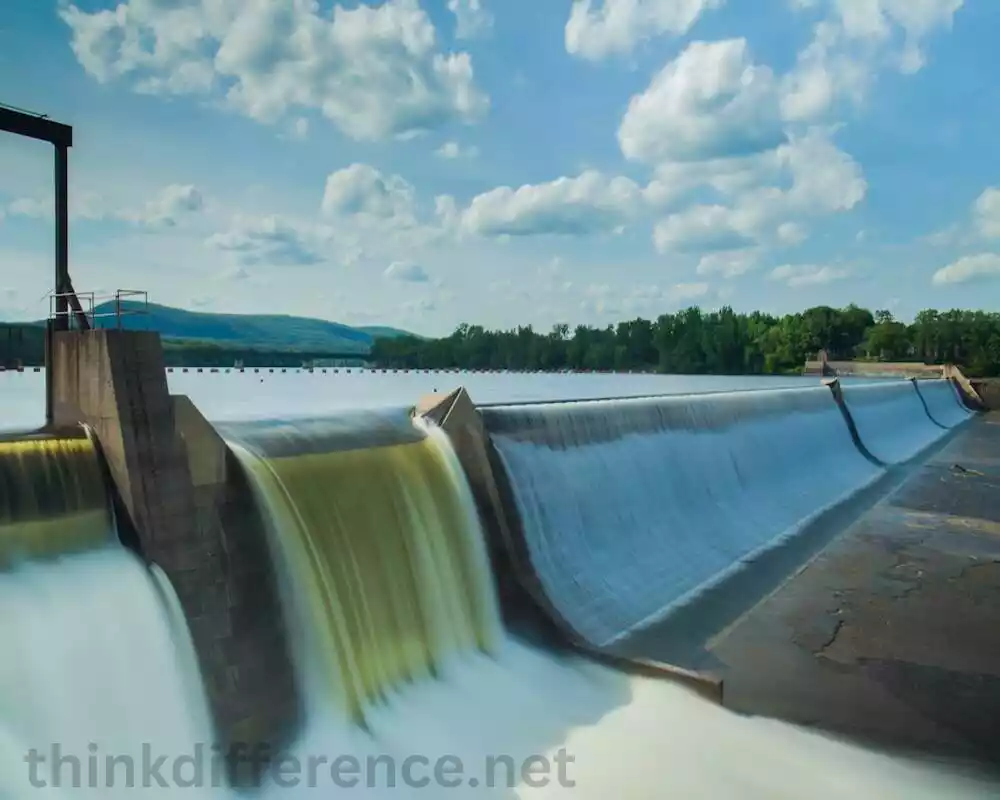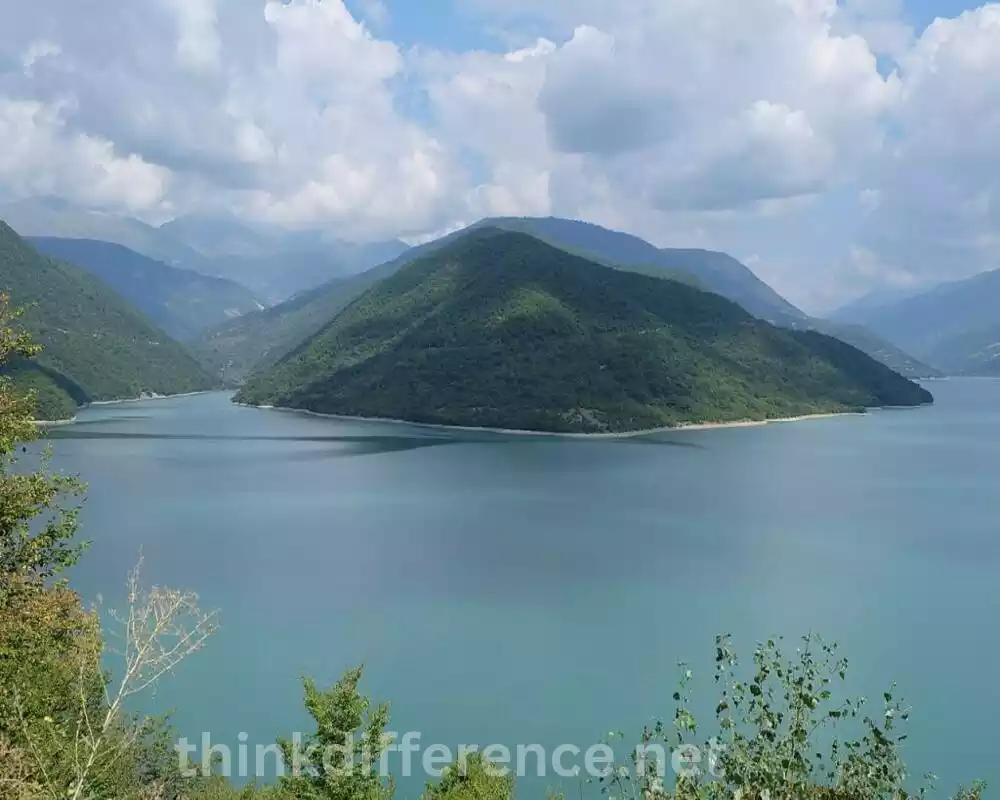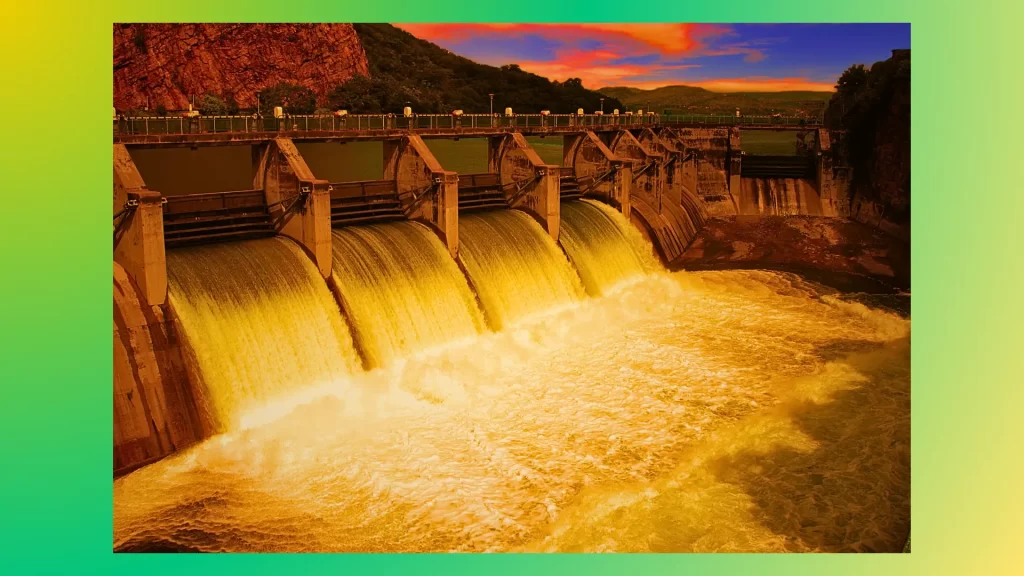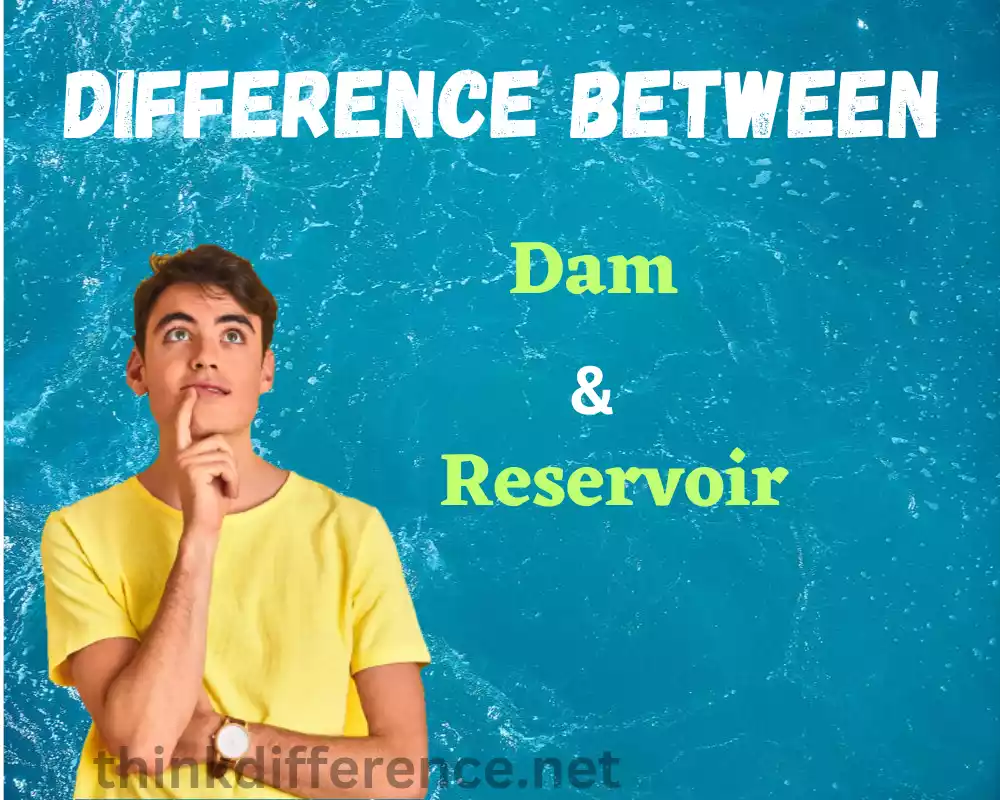Dam and Reservoir is play a vital role in water management systems worldwide. These engineering marvels are designed to harness the power of rivers and store water resources effectively. This article will focus on the construction and benefits of dams as well as their environmental effects, with particular attention paid to reservoirs as water management tools. We will also highlight their significance.
What is Dam?
Dams are artificial structures or barriers built across streams or rivers in order to block their flow of water and form lakes or reservoirs. Dams are typically built using various materials such as concrete, earth, or rock-fill, and are designed to withstand the pressure exerted by the impounded water. A dam’s primary function is to manage and direct water resources for various uses – be they irrigation, flood control or hydroelectric generation.

Dams are engineered to regulate the flow of water by storing it during times of excess and releasing it gradually when needed. This helps to ensure a reliable water supply during dry seasons or periods of high demand. The stored water behind a dam forms a reservoir, which acts as a water storage system, providing a buffer against droughts and enabling the controlled release of water for various uses.
In addition to water management, dams also have other functions. They can help prevent or mitigate flooding by capturing and controlling excessive rainfall or runoff. Dams are often used for hydropower generation, where the controlled release of water through turbines produces electricity. Enjoy recreational activities such as boating, fishing and wildlife observation.
Construction of dams can have both environmental and social ramifications. These include changes in the natural flow of rivers, alteration of aquatic habitats, disruption of fish migration, and displacement of communities living in the dam’s vicinity. Careful planning, environmental assessments, and mitigation measures are crucial to minimize the negative effects and ensure sustainable dam management.
Types of Dams
Dams can be classified into different types based on their design, construction materials, and engineering principles.
Here are some common types of dams:
- Concrete Dams: These dams are constructed primarily using concrete. They are strong, durable, and resistant to water seepage. Concrete dams can be further classified into two main types:
- Gravity Dams: These dams rely on their massive weight and gravity to resist the force of water. They are typically wide at the base and narrow at the top, enabling them to withstand the water pressure. Gravity dams are commonly used for large reservoirs.
- Arch Dams: Arch dams have a curved shape that transfers the water’s force to the abutments on the sides of the valley. They require less concrete compared to gravity dams and are suitable for narrow valleys with strong rock foundations.
- Earth and Rock-fill Dams: These dams are constructed by compacting and layering earth or rock materials. They are built using locally available materials and are relatively more flexible than concrete dams. Earth and rock-fill dams can be further classified into two main types:
- Embankment Dams: These dams are constructed by building an embankment of compacted earth or rock materials. They are typically used when suitable foundation materials are available nearby. Embankment dams can be made entirely of earth or a combination of earth and rock-fill materials.
- Rock-fill Dams: Rock-fill dams are primarily constructed using a combination of compacted rock and soil materials. They are often built in areas where the foundation conditions are suitable for rockfill placement. Geotextile or concrete face rock-fill dams may also be used to prevent erosion.
- Arch-gravity Dams: These dams combine the principles of both arch and gravity dams. They have a curved shape that provides additional strength against the water pressure. The weight of the dam and the arch action work together to resist the forces acting on the structure.
- Buttress Dams: Buttress dams consist of a series of reinforced concrete buttresses that support the weight of the dam and resist the water pressure. The buttresses are built on one side of the valley, and the spaces between them are filled with earth or rock-fill materials.
- Composite Dams: Composite dams are a combination of different dam types, such as concrete and embankment elements. They utilize the advantages of multiple materials to achieve the desired strength and stability.
Each type of dam has its advantages, limitations, and suitability for specific site conditions. The selection of a dam type depends on factors such as the size and shape of the reservoir, foundation conditions, availability of construction materials, and engineering considerations.
What is Reservoir?
Reservoirs are bodies of artificial or natural water created or altered through impoundment behind a dam and used as storage areas or man-made lakes for collecting rainwater. Reservoirs come in all shapes and sizes – from small ponds up to larger expanses – depending on their purpose in water management.

Reservoirs serve an integral purpose, they store and utilize water for various uses such as drinking, irrigation, industrial processes or hydropower generation. Reservoirs offer an ample source of regulated water when demand spikes due to scarcity. Reservoirs play a crucial role in managing our resources as they allow storage/collection when excess flows such as during heavy rainfall/snowmelt occur.
Dams are common structures built across rivers or streams to form reservoirs for collecting the flow of water behind their structures, creating reservoirs. Once collected behind, this water can then be released as needed from its storehouse to supply constant supplies year round – both providing needed supply during dry spells as well as controlled releases to mitigate flooding when heavy rainfall arrives. Reservoirs provide much-needed balance by providing needed supplies during periods of high demand while controlling flood releases when heavy precipitation arrives.
Reservoirs serve both utility and environmental-recreational functions, providing boating, swimming, fishing and wildlife observation activities within their waters. Reservoirs also act as habitats for aquatic plants and animals that support biodiversity preservation efforts as well as supporting conservation initiatives.
Reservoirs have both environmental and social repercussions. This may include flooding of land and alteration to river flows as well as changes to water quality or displacement communities. To ensure sustainable management of water resources while mitigating adverse consequences it is imperative that reservoirs are carefully managed. To minimise negative consequences and maximize long-term sustainability it is critical that reservoirs be managed carefully with regard to impacts arising.
Types of Reservoirs
Reservoirs can be classified into different types based on their purpose, location and formation.
Here are some common types of reservoirs:
- Storage Reservoirs: These reservoirs are designed primarily for storing and regulating water supplies. They are typically created by constructing dams across rivers or streams to impound water. Storage reservoirs provide a solution to managing water resources efficiently. By offering consistent and dependable access to drinking, irrigation, industrial production and hydropower generation purposes – among others – storage reservoirs help manage our precious resource of freshwater for everyday uses such as drinking, irrigation and hydropower production.
- Flood Control Reservoirs: Flood control reservoirs were created in order to decrease the severity of flooding impacts and lessen its negative consequences. They are strategically designed to capture and store excess rainfall or runoff during periods of heavy precipitation. These reservoirs help regulate the release of water downstream, reducing the risk of flooding in downstream areas and protecting lives, property, and infrastructure.
- Detention Reservoirs: Detention reservoirs are specifically designed to temporarily hold water and control its release. These devices help control water flows by decreasing peak flow rates during heavy rain events and, thus, reduce downstream flooding risks. Detention reservoirs are commonly used in urban areas to manage storm water runoff.
- Off-stream Reservoirs: Off-stream reservoirs are located away from the main river channel. These structures are created by diverting water from rivers or other sources into separate reservoirs or basins. Off-stream reservoirs are often used for water supply purposes, providing a storage facility that can be filled during periods of high flow and used during times of low flow or high demand.
- On-stream Reservoirs: Building dams over streams or rivers creates on-stream reservoirs. These dams impound river water directly and create large reservoirs behind them – perfect for flood control, storage purposes, hydropower production and recreational purposes alike. Reservoirs on-stream serve a number of important purposes such as flood control, storage needs and recreation activities.
- Natural Reservoirs: Natural reservoirs, also referred to as natural lakes or ponds, form through natural processes like tectonic activity, glacial action or volcanic eruption. These reservoirs exist without any human intervention and play important ecological roles, providing habitats for various plant and animal species.
- Recreation Reservoirs: Recreation reservoirs are designed and managed primarily for recreational purposes. Explore activities such as boating, swimming, camping and wildlife watching. Recreation reservoirs often have facilities such as picnic areas, boat ramps, and campgrounds to enhance visitors’ experience.
These are some common types of reservoirs, each serving different purposes and fulfilling various water management needs. The specific type of reservoir constructed depends on factors such as the intended purpose, location, available water resources, and environmental considerations.
The Importance of Dams and Reservoirs
Dams and reservoirs play a vital role in water resource management and provide various important benefits to society.
Here are some key reasons highlighting the importance of dams and reservoirs:
- Water Storage: Dams and reservoirs serve as crucial storage facilities, allowing water to be collected during periods of excess flow, such as heavy rainfall or snowmelt. This stored water can then be released during dry periods or times of high demand, ensuring a consistent and reliable water supply for domestic, agricultural, and industrial needs.
- Flood Control: Dams help mitigate the impact of floods by capturing and controlling excessive water flow. They regulate the release of water downstream, reducing the risk of downstream flooding and protecting communities, infrastructure, and agricultural lands from flood damage.
- Hydropower Generation: Hydropower electricity generated from dams, is one of the primary renewable power sources available today. The controlled release of water through turbines in a dam’s power station produces electricity, contributing to the energy needs of a region and reducing reliance on fossil fuel-based power generation.
- Irrigation and Agriculture: Reservoirs formed by dams provide water for agricultural irrigation, enabling the cultivation of crops in areas with limited rainfall. Irrigation from reservoirs enhances agricultural productivity and food security while helping rural economic development.
- Water Supply: Reservoirs act as water supply sources for municipalities and communities. They store and provide treated water for domestic use, ensuring a reliable and continuous supply of clean drinking water to meet the needs of growing populations.
- Recreation and Tourism: Recreational activities like boating, fishing and swimming as well as wildlife watching may all be available at reservoirs. These activities contribute to tourism, local economies, and the overall well-being of communities living near reservoirs.
- Environmental Conservation: Dams and reservoirs can contribute to environmental conservation efforts. They can help regulate water flows to support ecosystems downstream, maintain wildlife habitats, and preserve aquatic biodiversity. Reservoirs provide another effective means of water management that benefits wetlands, wildlife refuges and protected areas.
Although dams and reservoirs provide many environmental advantages, they also present some dangers, including disrupted fish migration patterns and changes to water quality. Sustainable management and proper environmental assessments are essential to minimize these impacts and strike a balance between the benefits and potential drawbacks of these water management systems.
Comparison between Dams and Reservoirs
Dams and reservoirs are closely related and often go hand in hand. Here’s a comparison between dams and reservoirs:
1. Definition:
- Dam: A man-made structure or barrier constructed across a river or stream to impound or control the flow of water.
- Reservoir: An artificial or natural body of water that is created or modified by the impoundment of water behind a dam or similar structure.
2. Function:
- Dam: Dams primarily serve to control and manage the flow of water, regulate water release, and provide structural support for the impounded water.
- Reservoir: Reservoirs are the result of impounded water behind a dam and serve as storage spaces for water, allowing for its controlled release and utilization for various purposes.
3. Purpose:
- Dam: Dams are built for purposes such as water storage, flood control, hydropower generation, irrigation, and water supply.
- Reservoir: Reservoirs store water to meet an array of purposes such as drinking, irrigation, industrial processes and hydropower generation.
4. Structure:
- Dam: Dams are engineering structures constructed using materials such as concrete, earth, or rock-fill, designed to withstand the forces exerted by impounded water. They can take various forms, including gravity dams, arch dams, embankment dams, etc.
- Reservoir: Reservoirs are the bodies of water formed behind dams, created by impounding or collecting water. Size and shape options of these ponds range from small to large.
5. Environmental Impact:
- Dam: The construction of dams can have significant environmental impacts, including changes in river flow patterns, alteration of aquatic ecosystems, disruption of fish migration, and land and habitat alteration.
- Reservoir: Reservoirs can impact the environment by flooding land, altering natural landscapes, and affecting the flora and fauna in the submerged areas. They can also provide new habitats for aquatic species and support biodiversity.
6. Recreational Use:
- Dam: Dams themselves do not typically offer recreational opportunities, as they are primarily engineering structures. Certain types of dams, such as embankment dams, may include recreational areas or facilities.
- Reservoir: Reservoirs created by dams often provide opportunities for recreational activities like boating, fishing, swimming, camping, and wildlife observation.
Dams are the structures built across rivers or streams to control water flow, while reservoirs are the bodies of water created by impounding water behind dams. Dams serve various purposes, while reservoirs store water for different uses and can offer recreational opportunities. Dams and reservoirs both pose negative environmental effects through their construction and operation, leaving an environmental legacy behind them.
Benefits of Dams and Reservoirs
Dams and reservoirs provide numerous benefits for water resource management and human societies.
Here are some key benefits:
- Water Storage: Dams and reservoirs serve as storage facilities that enable water to be collected during times of high flow such as heavy rainfall or snowmelt and stored until such times when more is required for consumption or release. The stored water can then be released gradually during dry seasons or periods of high demand, ensuring a reliable water supply for various purposes like drinking water, agriculture, industry, and hydropower generation.
- Flood Control: Dams play a crucial role in mitigating the impacts of flooding. They can capture and store excessive rainfall or runoff, reducing downstream flood risks. By regulating the release of water, dams help control and manage river flows during periods of heavy precipitation, protecting lives, property, and infrastructure in downstream areas.
- Hydropower Generation: Dams are essential for hydropower generation. Hydroelectric power plants produce electricity by discharging controlled amounts of water into turbines – an environmentally-friendly and renewable form of power production that meets energy demands while helping meet fossil-fuel reduction goals and mitigating greenhouse gas emissions. Hydropower produced at dams helps meet our energy requirements while mitigating greenhouse emissions.
- Irrigation: Dams and reservoirs provide water for agricultural irrigation, enabling farmers to sustain crop growth and increase agricultural productivity. Irrigation systems fed by reservoirs help mitigate the impacts of drought and contribute to food security by ensuring consistent water supply for farming.
- Water Supply: Reservoirs created by dams act as water supply sources for municipal, industrial, and domestic use. Water stored can then be treated and made available for drinking, sanitation and other domestic needs.
- Recreation and Tourism: Reservoirs formed by dams often provide opportunities for recreational activities like boating, fishing, swimming, camping, and wildlife observation. These activities offer recreational spaces where individuals can experience nature while engaging in leisure-time activities, while contributing to local tourism industry development and economic progress.
- Biodiversity and Habitat Creation: Reservoirs provide an ideal setting to foster biodiversity by creating habitats. The flooded areas can become habitats for fish, waterfowl, and other aquatic species, contributing to ecological diversity and conservation initiatives.
- Drought Management: Dams and reservoirs help manage water resources during periods of drought. They store water during times of abundance and release it during dry spells, mitigating the impacts of water scarcity and ensuring water availability for critical needs.
Although dams and reservoirs provide many benefits, they also can have serious environmental and social ramifications that should be managed appropriately in order to ensure sustainable management practices that ensure responsible dam and reservoir operations such as managing ecosystem disruption, changing water quality or displacement of communities.
It is vitally important for responsible management practices by conducting environmental studies as well as taking mitigating measures into consideration in order to achieve long-term sustainable management practices for dams/reservoirs.
Environmental Considerations
Consideration must be given to the environmental effects of dams and reservoirs when considering their construction and operation.
Here are some key environmental considerations:
- Ecosystem Disruption: The construction of dams and the formation of reservoirs can significantly alter natural river ecosystems. The flooding of land can lead to the loss of terrestrial habitats, wetlands, and riparian zones. This disruption can negatively impact plant and animal species that depend on these habitats, affecting biodiversity and ecosystem functioning.
- Fish Migration: Dams can impede the migration of fish species that rely on free-flowing rivers to spawn or complete their life cycles. Barrier dams can prevent fish from reaching their traditional breeding or feeding grounds, leading to declines in fish populations and disruptions in the aquatic food chain.
- Water Quality Changes: Reservoirs can have an impact on water quality. The impounded water can experience changes in temperature, oxygen levels, and nutrient concentrations. These alterations can affect aquatic organisms and lead to the growth of harmful algae or other water quality issues. The accumulation of sediments behind the dam can change downstream sediment transport patterns.
- Sedimentation: Dams can trap sediment carried by rivers, resulting in the accumulation of sediment behind the dam. This can reduce the downstream supply of sediment, affecting riverbed stability, nutrient cycling, and the natural erosion and deposition processes downstream. Sediment build-up can also reduce the storage capacity of reservoirs over time.
- Downstream Flow Regime: Dams alter the natural flow patterns of rivers by regulating water release. This can disrupt downstream ecosystems that have evolved to depend on natural flow variations, such as floodplain inundation and seasonal changes. Changes in flow regime can impact aquatic habitats, water availability for downstream users, and the health of riparian ecosystems.
- Land Use and Habitat Loss: The construction of dams and reservoirs often requires clearing land and inundating large areas. Loss of forest and agricultural lands as well as other forms of habitats (whether natural or man-made) is one result, forcing species into unfamiliar territories where adaptation or finding alternative dwelling places might prove challenging.
- Greenhouse Gas Emissions: Reservoirs can be an abundant source of greenhouse gasses, particularly methane. The submerged organic matter in reservoirs can decompose under anaerobic conditions, releasing methane, a potent greenhouse gas. This contributes to the carbon footprint associated with dam construction and operation.
Addressing these environmental considerations requires careful planning, design, and management practices. Strategies such as incorporating fish passages to facilitate fish migration, implementing sediment management measures, and maintaining minimum environmental flow releases can help mitigate some of the environmental impacts.
For the long-term conservation and sustainability of ecosystems affected by dams, conducting environmental impact analyses, monitoring programs, and employing adaptive management techniques is imperative.
Challenges and Controversies
Dams and reservoirs are often associated with various challenges and controversies.
Here are some of the key issues:
- Environmental Impact: Environmentalists and conservationists are concerned about reservoirs and dams’ environmental effects, including habitat destruction, altered natural flow patterns, disruptions of ecosystems and displacement of species populations. Large dams can have profoundly negative impacts on river ecosystems, biodiversity and fish populations.
- Displacement of Communities: The construction of dams and reservoirs often requires the resettlement of communities living in the affected areas. Migration may lead to displacement of native peoples, loss of livelihood and social disruption. Resettled communities may face challenges in adapting to new environments, accessing resources, and maintaining their cultural practices.
- Social and Cultural Impacts: Dams can have profound social and cultural impacts on affected communities. Loss of ancestral lands and sacred sites is known to result in the erosion of traditional identities and practices, undermining cultural identities and practices that shape lives across time and cultures. Social conflicts and tensions can arise due to unequal distribution of benefits and compensation, and the disruption of local social structures.
- Cost and Financing: Large dam projects can be financially demanding, requiring significant investments in design, construction, and maintenance. The costs associated with dam construction and operation can be a burden on governments and can sometimes lead to cost overruns. Financing such projects can also involve complex arrangements and international funding, which may raise concerns about transparency and debt sustainability.
- Geopolitical Issues: Dams constructed across transboundary rivers can give rise to geopolitical tensions and disputes among neighboring countries. Conflicts may arise over water sharing, downstream impacts, and potential changes to water availability for riparian nations. Resolving these conflicts often requires international cooperation, negotiation, and agreements.
- Long-Term Sustainability: Dams and reservoirs have a lifespan and require ongoing maintenance and monitoring to ensure their long-term sustainability. Sedimentation, reservoir aging, and the need for repairs and upgrades pose challenges for the continuous operation of dams. Climate change impacts, such as altered rainfall patterns and an increase in hydrological fluctuations, can adversely impact existing dams’ performance.
- Alternatives and Sustainable Solutions: Critics argue that alternative methods of water resource management, such as water conservation, efficiency measures, and decentralized water systems, should be explored before resorting to large-scale dam construction. Sustainable solutions that minimize the environmental and social impacts while meeting water and energy needs are increasingly being advocated.
Addressing these challenges and controversies requires a balanced approach that considers the social, environmental, and economic aspects of dam projects. Engaging stakeholders, conducting environmental impact analyses, using transparent decision processes and adopting eco-friendly technologies and practices are essential steps towards sustainability.
Consideration of alternatives and the integration of multiple perspectives are crucial for finding solutions that optimize the benefits while minimizing the negative impacts associated with dams and reservoirs.
Future Trends in Dam and Reservoir Technology
Future trends in dam and reservoir technology are expected to focus on improving efficiency, sustainability, and adaptability to address evolving challenges.

Here are some potential trends that may shape the future of dam and reservoir technology:
- Smart Dam Monitoring and Maintenance: Real-time monitoring of dam conditions will soon become possible thanks to advanced monitoring systems employing artificial intelligence, Internet of Things technology and remote sensing techniques. This includes structural health monitoring, seepage detection, and early warning systems for potential failures. Predictive analytics and machine learning algorithms will aid in optimizing maintenance schedules and improving the overall safety and performance of dams.
- Climate Resilience and Adaptive Design: With climate change impacts becoming more pronounced, future dam and reservoir projects will prioritize climate resilience. This includes considering changing hydrological patterns, extreme weather events, and sea-level rise in the design and operation of dams. Flexible design features, such as adjustable spillways and flood management strategies, will help mitigate the impacts of climate variability and reduce the risk of damage.
- Sustainable Sediment Management: Sediment management will continue to be a key focus in dam and reservoir technology. Innovations in sediment control and management techniques will be employed to prevent excessive sedimentation, maintain reservoir storage capacity, and minimize downstream impacts. This may involve strategies like sediment bypass systems, sediment trapping structures, and sediment flushing to maintain the ecological balance of river systems.
- Nature-Based Solutions: Embracing nature-based solutions will be an emerging trend in dam and reservoir technology. This includes incorporating ecological considerations into dam design and operation, such as the creation of fish passage structures, wetland restoration, and habitat enhancement. Restoring natural river processes and connectivity can help mitigate ecological disruptions caused by dams and reservoirs.
- Improved Fish Passage Technologies: Enhancing fish passage through dams will be a priority to restore migratory routes and support fish populations. Future technologies may include fish-friendly turbines, fish lifts or ladders, and advanced fish monitoring systems. These measures will help mitigate the negative impacts on fish migration caused by dam construction and operation.
- Integrated Water Management: Integrated water management approaches will gain prominence, emphasizing the holistic management of water resources. This includes optimizing the use of stored water in reservoirs, coordinating water releases for multiple purposes (e.g., water supply, irrigation, hydropower), and integrating water allocation with ecological and environmental considerations. Integrated water management will promote more efficient and sustainable use of water resources.
- Green and Sustainable Hydropower: Environmentally sustainable hydropower technologies will continue to develop. This may involve improving turbine efficiency, enhancing energy storage capabilities through pumped storage systems, and integrating hydropower with other renewable energy sources like solar and wind. Hydropower will be optimized to maximize its sustainability while minimizing environmental impacts.
- Community Engagement and Stakeholder Participation: Future dam and reservoir projects will increasingly prioritize community engagement and stakeholder participation. As it relates to decision-making processes, involving local communities, indigenous groups and other stakeholders – along with their perspectives and concerns – in decision making is of utmost importance. Utilizing participatory approaches allows projects to be developed while taking into consideration social, economic and cultural wellbeing of affected communities.
By embracing these future trends, the development and management of dams and reservoirs can become more sustainable, resilient, and environmentally friendly. Future success for dams and reservoirs lies in their ability to satisfy both ecosystem concerns and social equity, while remaining cost effective and beneficial structures.
Last Words on Dam and Reservoir Technology
Dams and Reservoirs have significantly shaped the development and progress of human civilizations. From providing water for irrigation and domestic use to generating clean energy, these engineering marvels hold immense potential for the future. Balancing developmental needs with environmental considerations will be essential to ensure a sustainable and prosperous future for generations to come.


